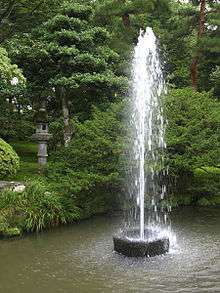Three Great Gardens of Japan

The oldest water fountain in Japan continues functioning at Kenroku-en in Kanazawa.
The Three Great Gardens of Japan (日本三名園 Nihon Sanmeien), also known as "the three most famous gardens in Japan" are considered to include Kenroku-en in Kanazawa, Koraku-en in Okayama and Kairaku-en in Mito.[1]
The conception of gardens in a group of three is found elsewhere; for example, in the three gardens of Emperor Go-Mizunoo who abdicated in 1629. At Shūgakui rykū, Go-Mizunoo maintained landscaped areas at separate elevations on the northeastern outskirts of Kyoto.[2]
- Kenroku-en means "garden which combines six characteristics"[3] – the six aspects considered important in the notion of an ideal gardens: spaciousness, serenity, venerability, scenic views, subtle design, and coolness.[4]
- Koraku-en means "garden of pleasure after", which is a reference to a saying attributed to Confucius—explaining that a wise ruler must attend to his subjects' needs first, and only then should he consider his own interests.[5]
- Kairaku-en means "a garden to enjoy with people." Nariaki Tokugawa who completed the garden, opened this private garden to the general populace. This was a novel concept which eventually led to the development of public parks.[6]
See also
Notes
- ↑ Lewis, Caroline. "Kenrokuen Garden Kanazawa," JapanVisitor.com; Koraku-en, Japan-Guide.com; and
- ↑ Japan Society of London. (1989). Proceedings, Issues 112-120, p. 54.
- ↑ "Kenroku-en," Ishikawa Prefecture, 2003.
- ↑ Bornoff, Nicholas. (2008). National Geographic Traveler Japan, p. 150.
- ↑ "Koraku-en," GoJapanGo.com; "Kairaku-en," Japan National Tourist Organization (JNTO).
- ↑ Kairaku-en garden, JapanAtlas.com
References
External links
| Wikivoyage has a travel guide for Japan's_Top_3. |
- Kenroku-en official website
- Japan Atlas: Kenrokuen
- Okayama Korakuen Garden official site (Japanese)
- Kairaku-en official website (Japanese)
This article is issued from Wikipedia - version of the 10/29/2016. The text is available under the Creative Commons Attribution/Share Alike but additional terms may apply for the media files.